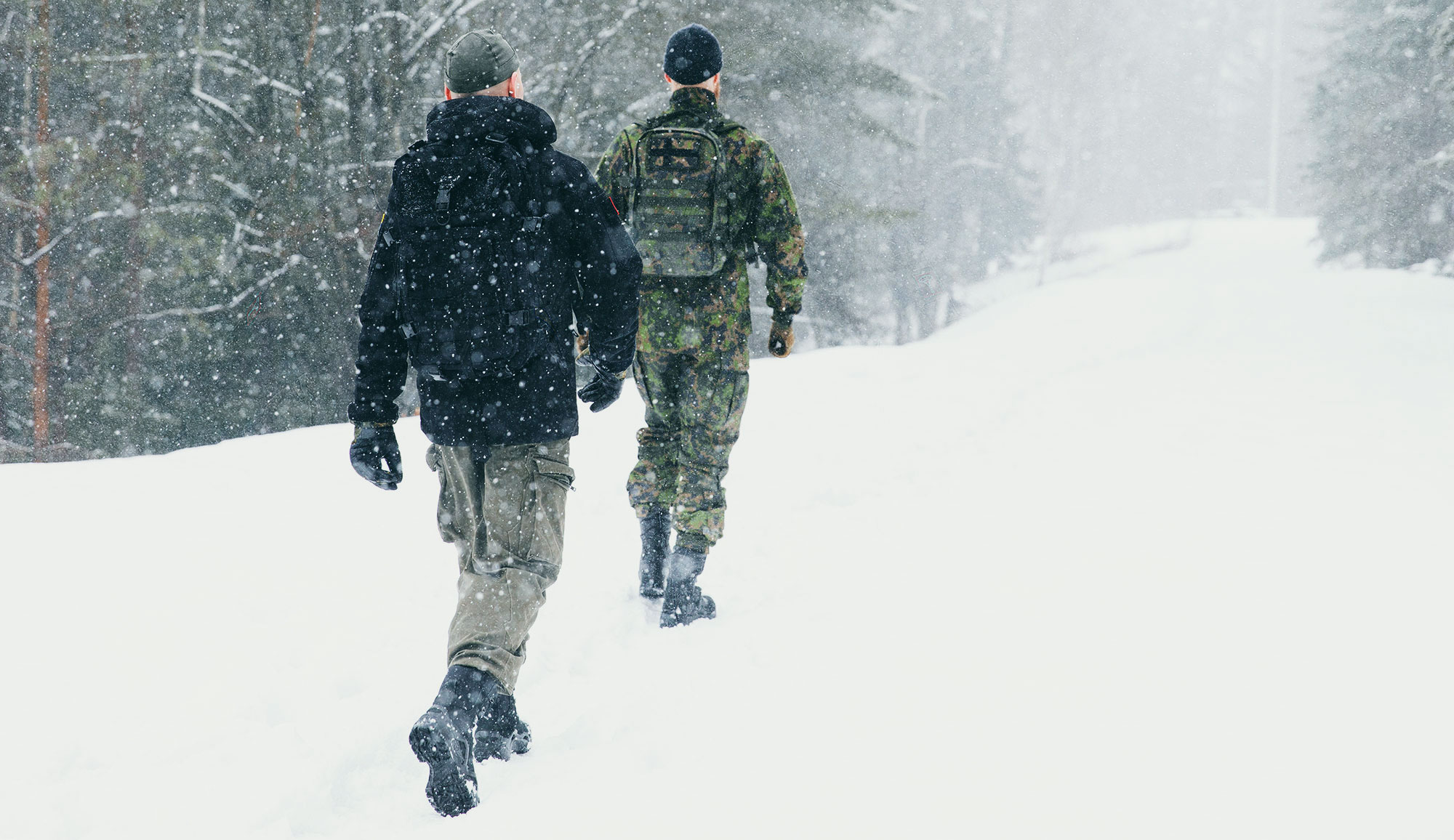March or Die! A Basic Guide to Military-Style Movement on Foot
Loaded marching is a major part of soldier skills. Everyone who served should have memories of marches, healed by time. It sucked back then but afterwards all those klicks are warmly remembered.
This article covers the basics of preparing for a loaded march, clothing and equipment and execution of the march itself. There are many means to an end and this is not the only truth, but a fair amount of ground has been covered by employees of Varusteleka (in armed service as well as reservists) to form and compile these experiences and advice.
The purpose of marching
Marching is a way to advance forces over ground. It should not be seen as a standalone thing, but soldiers must maintain combat readiness before, during and after the march. This should be considered as part of the objective: can you complete the march without exhausting yourself mentally and physically? Too often people look to cross the finish line and drop there and then.
Of course, long marches are imporant and taxing events but keep in mind the original purpose of marching and be honest with yourself.
Marching is a good way to maintain fitness and find the limits of your performance. With experience, you can find an ease of mind and especially over longer distances you can get pretty deep into your head. At its best, marching practice and marches are a perfect combination of physical exercise and meditation.
How to practice marching
Marching doesn't require top-level athletic condition, just regular fitness gets you far. In practical terms, you can assume that a 20-30 km (12.5-18.5 mi) with a 10-15 kg (22-44lbs) load can be completed by a healthy person in 4-6 hours without being a sore noodle afterwards. The situation does change when the distance, load, pace or all of these are increased.
The best practice for marches is marching itself. Shorter and longer distances, various loads and various paces over different kinds of ground. Jogging helps but don't count on running fitness alone. A backpack and boots are different animals and require a lot of practice to get used to.
In addition to marching and running, work your legs and core muscles. A good many marches have been finished short because of severe back pain, knee- or Achilles tendon injuries. Having abs and back muscles help carry the backpack and reduces risk of injury when you're tired. The legs should be diversely trained to ensure a sufficient condition to protect your knees and ankles. If you aren't familiar with this kind of training, it's advisable to consult a professional, tell what you're up to and ask for advice to get a good program.
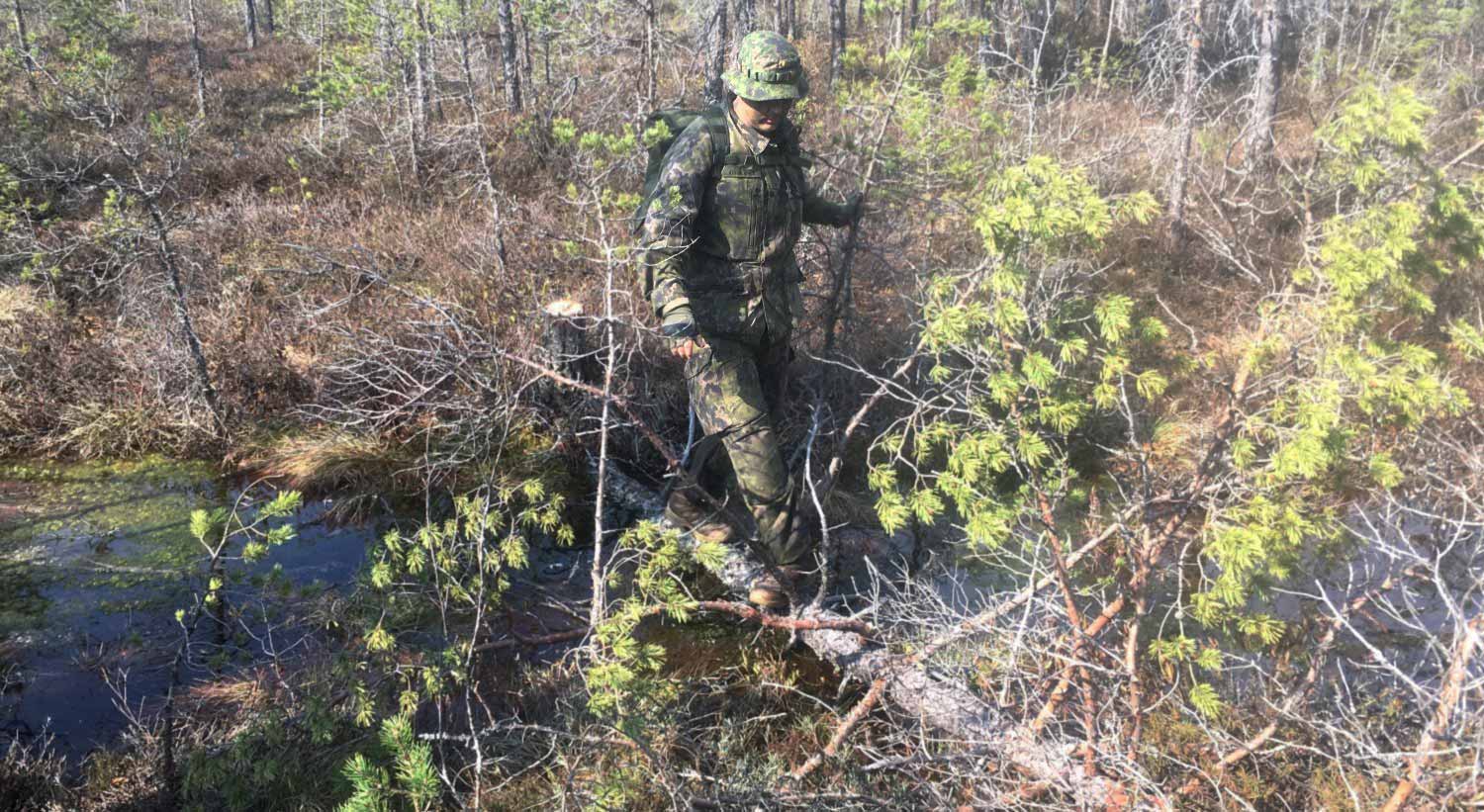
The key point is to have trained enough to know your body and its performance. Practice also boosts your confidence during the march, as various sensations won't surprise you.
Equipment and clothing for marching
Marching is certainly not an equipment-sport but as usual, high-quality and functional gear will help minimize the suck on the road.
Footwear
Boots are the most important piece of equipment. Usually these are high lace-up boots as used by various armed forces. Bad shoes or boots have ended many efforts despite the wearer being in top shape.
The top priority is having a good fit and wear-in to your feet. Ensure that the toes don't touch the front but the fit should be tight enough to support and hold the foot steady. There are no shortcuts here, you have to put the work into this yourself.
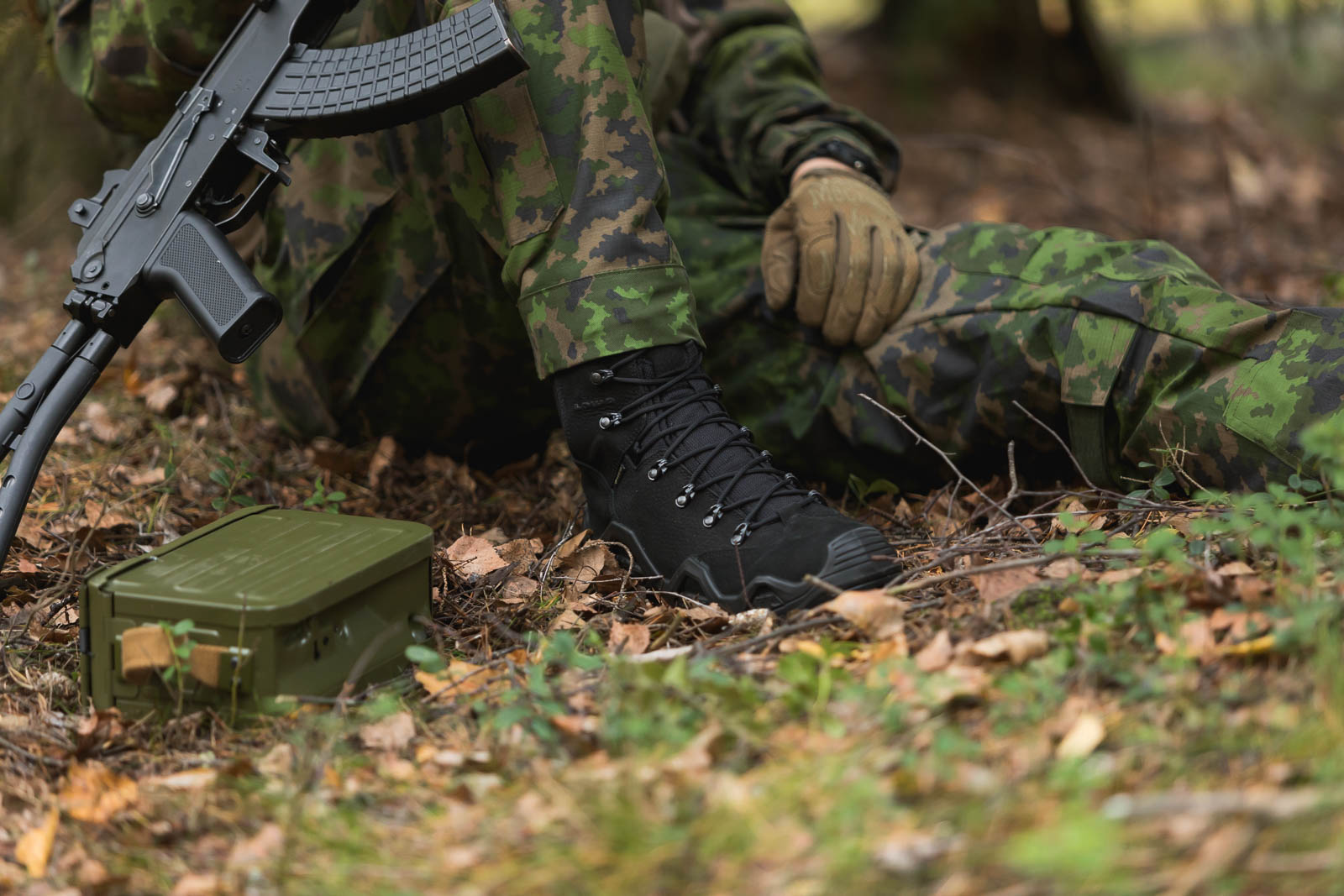
This product group has nice footwear options.
Socks
Proper socks are another staple of marching equipment. The socks should fit without wrinkling and bunching as well as have flat seams. They should wick moisture (or reject it) and dry quickly. Your feet will also love soft materials.
The role of socks is important from the first step to the last. They reduce friction around the feet as your feet inevitably move a little inside the boots. Many swear by double or even triple socks for marches. When socks are worn as layers, friction is soaked up by each sock to prevent the skin from blisters and chafing.
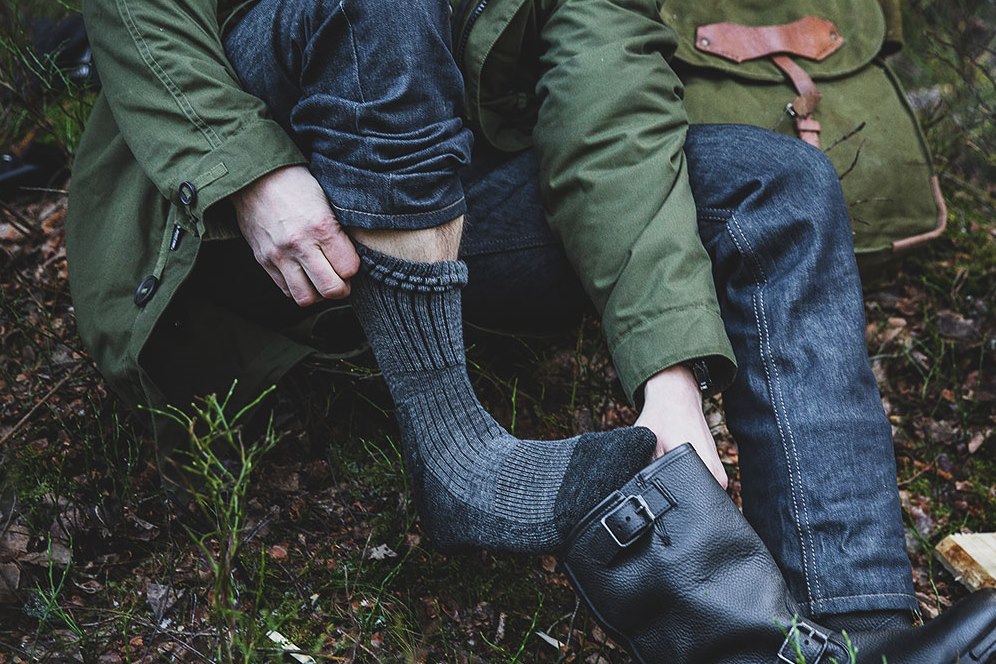
Again, socks are an individual choice that you should seek out by trial and error. This product group has nice sock options.
Backpack
A backpack or rucksack is certainly noteworthy when it comes to loaded marches. Depending on the event, you must carry the required weight or equipment on your back. In addition to meeting outside requirements, the pack must be suitable for the wearer.
Typical loads to be carried from start to finish is between 10-20 kg (22-44lbs) and earnest folks will carry in excess of 40 kg (88 lbs). Choose the appropriate pack for the load unless you're a masochist and consider a waistbelt to distribute the weight even with a small backpack.
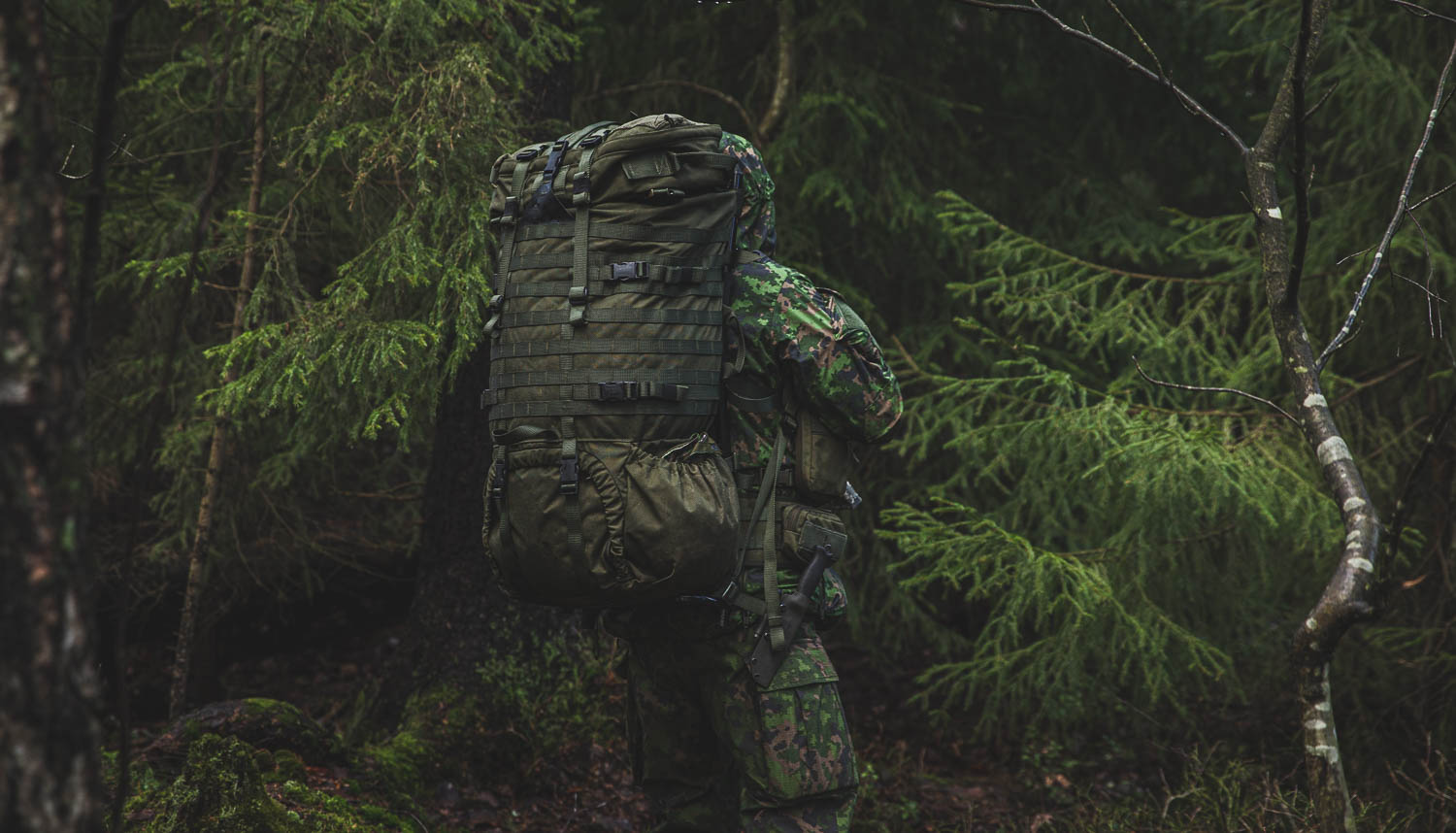
It pays off to familiarize yourself with all adjustments of your pack. When adjusted correctly, you shouldn't have hot spots on your shoulders or chafed hips no matter how much load you carry. This product group has various backpack options.
Clothes
What you wear affects your performance through heat management. An ordinary soldier produces 2300-3200 kJ of heat per hour when marching with a 25 kg (55 lbs) load. With this in mind, choose clothes that can be adjusted to vent heat to avoid overheating and dehydration through sweating. A good rule of thumb is if you're cold while waiting to go, you are likely to be good when you get going.
Obviously, your clothes shouldn't chafe, bind or restrict movement. The base level should wick (or reject) moisture just like your socks. As an additional challenge, the clothes must protect you from exposure (wind, rain, sun etc.) and mechanical hazards like sticks and rocks. Our experience favors merino wool against the skin (L1) and the Särmä TST L4 Field Jacket and L4 Field Pants as the outer layer for the Finnish environment. We dare claim this is a combination that works across a wide range of weather all around the world.
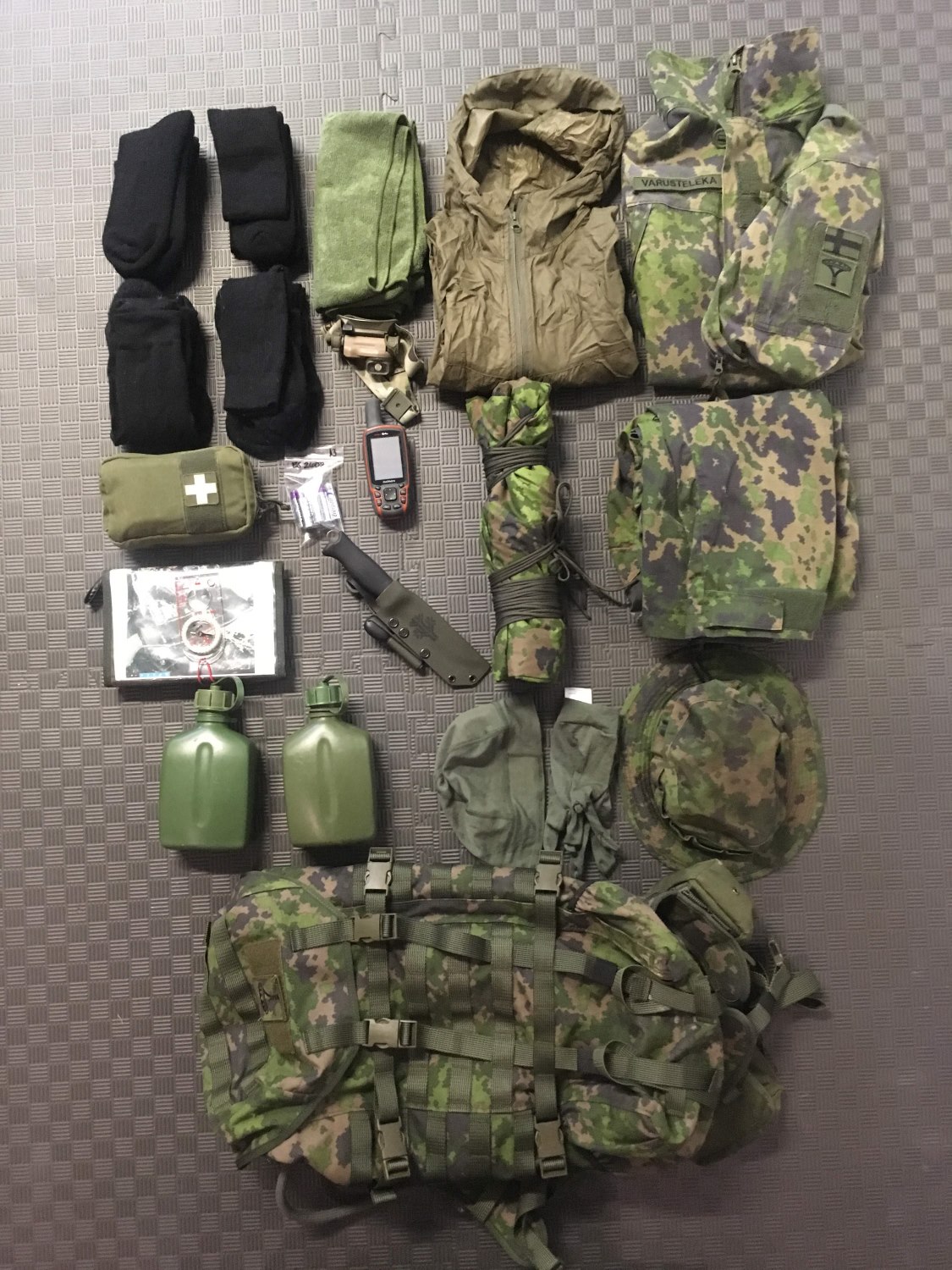
What you wear aren't all the clothes with you. It makes sense to carry a windbreaker to prevent getting cold during the breaks. This allows you to continue with a higher morale without warming up again.
This product group has all the clothes you will need for any march.
First aid and preventative measures
Shit happens. The usual plight is a blister on your foot. Another common setback is a sprain or stress-injury of the lower limb. These should be prepared for at the very least.
In addition to your first aid kit, which may already include a chest decompression needle, pressure bandage and nasopharyngeal airway, you are likely to need antiseptic wound cleansers, blister band-aids, gymnastics tape or duck tape, a sterile needle and sharp scissors. This set usually mitigates superficial issues and allows you to continue. Elastic bandages may also be a good idea to treat a sprained ankle or knee.
Chamois crème and talcum powder are also worth their weight in gold to keep your arse smooth and slick. Other good spots to give a dab are the armpits, nipples and crotch. Talcum powder helps manage moisture. The best time to practice and get used to these performance-enhancing tricks is before you need them. See this product group for first aid items.
An example of the foot-care kit for a 50 km (31 mi) march:
- Wet wipes (for cleaning your feet)
- Small towel (for drying your feet)
- Blister bandages
- Individually packed wound cleansing wipes
- Small roll of wide Gorilla tape (for serious SHTF)
- A couple of sterile needles (for emptying blisters)
- Small scissors (sharp!) and a nail file for maintaining your nails and trimming possible tape-jobs
Other useful pieces of equipment
All essential survival equipment should also be included in your marching kit, including but not limited to a light source, firestarter, map and compass. If the route goes along roads with any traffic and the scenario doesn't include avoiding enemy surveillance, a reflector or blaze orange/yellow flag on the backpack can be used for added safety.
Typical road marches don't require orienteering but the routes may not be marked that clearly. Carry a map of your own to be sure of the direction. Think of it as map-reading practice even if it's not mandatory: it's part of combat readiness and general knowledge to be aware of your location at all times.
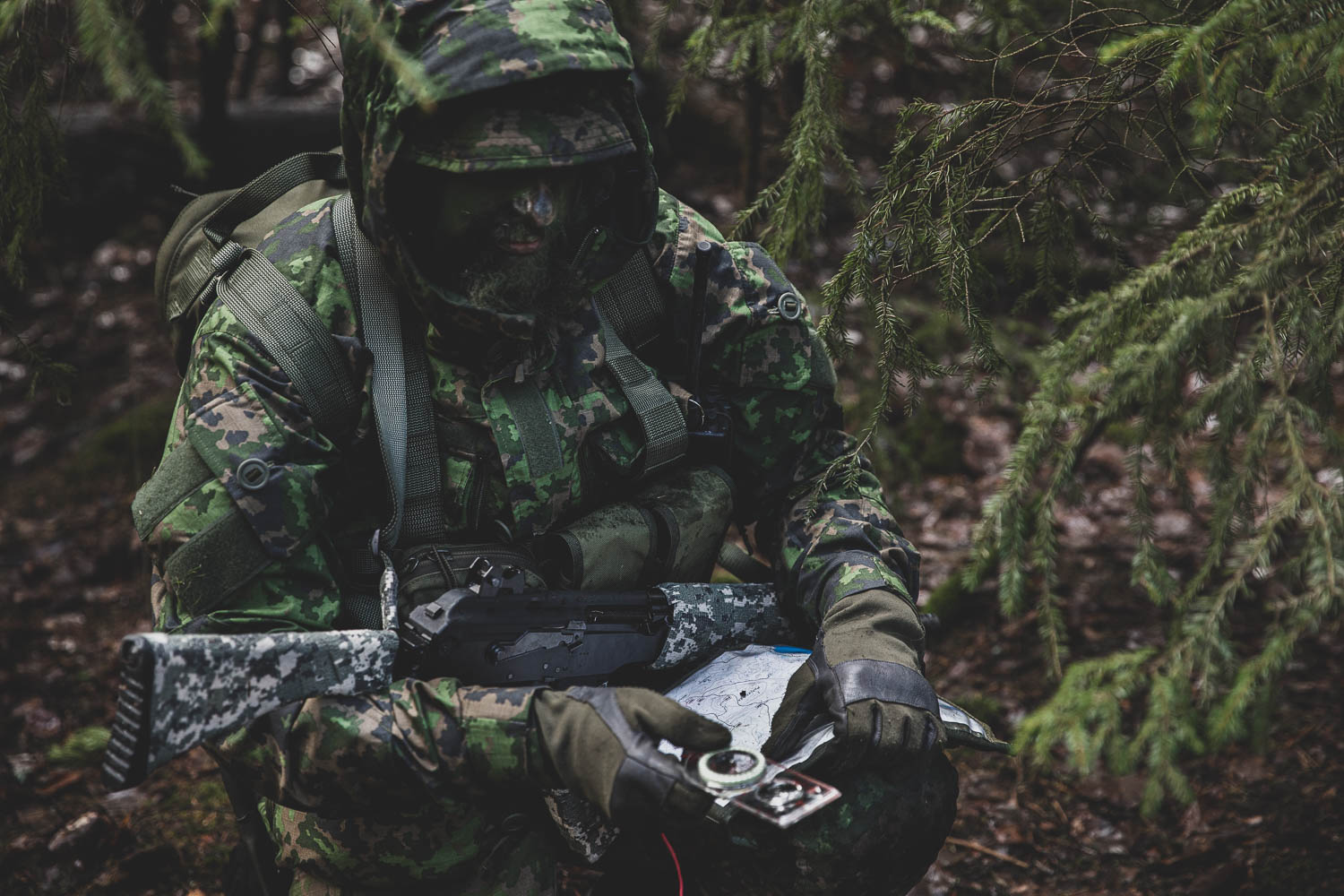
A small supply of toilet paper and wet wipes will help you in case nature calls on the way. A less likely but incredibly useful "don't ruin your march"-card is a pair of spare laces for your boots.
Preparations before marching
You should start getting ready as soon as the decision to participate in a march is done. The boots, socks, pack and other vital equipment should be tested as you practice. Don't bring along anything you're not familiar with.
Caring for your feet is a forward-approach thing as well. Any hard spots, warts and this kind of issues should be sorted weeks before you put the left foot over the startline. If you have any problems in the start, the likelihood of trouble on the way increases exponentially and another multiplier is distance.
Clip and file your nails well beforehand. Ensure there are no sharp corners, fractures and that the nails don't bother other toes on either side. Clipping reveals more sensitive skin underneath and it needs time to get used to the new look.
Some people swear by taped feet. It's not advisable to count on this, but practice and the correct equipment. Keep in mind that marching is a war-time skill and achieving a hygienic and generally good tape-job in the field can be impossible. If you do take this route, practice it. Use high-quality tape and avoid wrinkles, impurities and sharp corners.
Before the march, take extra care of personal hygiene especially around the crotch, armpits and other spots susceptible to chafing.
Comb through the boots and socks you intend to use. Make sure nothing is broken and remove lint balls, loose threads and other gremlins that could chew your feet into minced meat.
Clean the boots inside out and loosen trapped dirt and sand from under the insoles, inside seams and other nooks and crannies. Use a vacuum cleaner as an extra measure.
Eat and drink during the 24 hours up to the march to be hydrated and well in the start. For an ordinary 25-50 km (15.5-31 mi) march you don't need any mystical bulk-up, just good home-cooked meals and water. In this phase, don't mess up your diet by introducing anything new. Stay with familiar foodstuffs that you can handle.
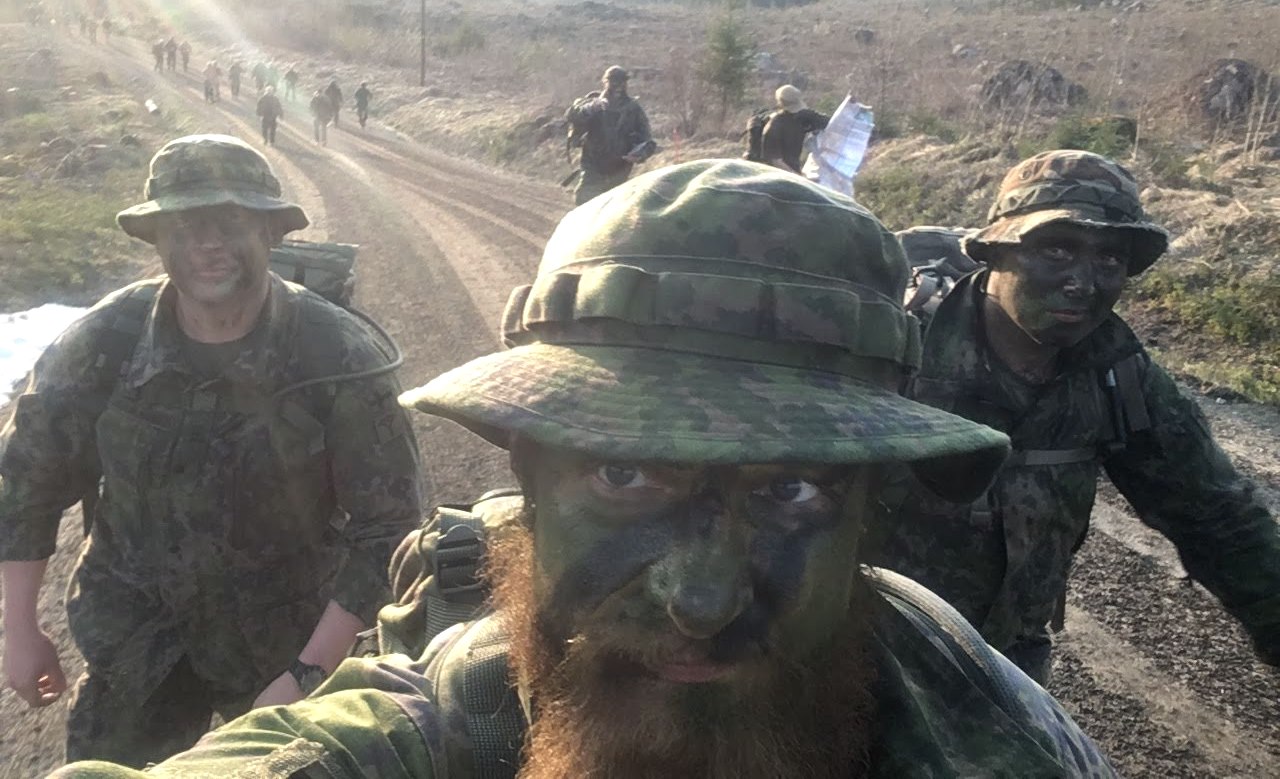
Make a plan as soon as you know the route. Obtain maps to cover the whole route to be familiar with it and choose a pace and break spots. Once you have made a plan, stick to it. Increasing the pace or skipping breaks may feel attractive on the go but may come back to bite you in the ass later.
Common mistakes include starting with a fast pace or get going without any idea of breaks, how often and how long they should be held. A good march will have a steady pace, breaks are kept as planned and in the end you remain functional.
Here are some examples of break plans used by marchers at Varusteleka. The patrol leader helps to send the team off on time.
| Example one, 50 km (31 mi) March | ||
| Elapsed distance | Break time | Break tasks |
|---|---|---|
| 12.5 km | 5 min | Equipment check |
| 25.km | 20 min | Foot care, sock change, eating |
| 37.5 km | 5 min | Equipment check |
| 50 km | Finish | |
| Example Two, 50 km (31 mi) March | |
| Elapsed distance | Break time |
|---|---|
| 10 km | Break max. 5 min |
| 20 km | Break max. 5 min |
| 30 km | Break 15-25 min |
| 40 km | Break max. 5 min |
| 50 km | Finish |
The march
Marching itself is simple: put one foot before the other and keep going at a steady pace without breaking yourself.
The typical pace on roads and easy terrain varies between 4.5-6.5 km/h (2.8-4.0 mph). For a 25 km (15.5 mi) march this means between 3h 50min - 5h 30min excluding breaks. If breaks add up to 20 minutes the total time will be between 4:10 - 5:50 h. If the breaks extend over the plan, it will be difficult to take any of the time back by marching.
As a rule of thumb, a suitable balance is using 5-10% of the total time for breaks. This should be enough to maintain combat readiness while meeting time constraints. Keep track of your pace with a watch and map or a GPS if you prefer. The patrol leader or individual must correct the pace as necessary.
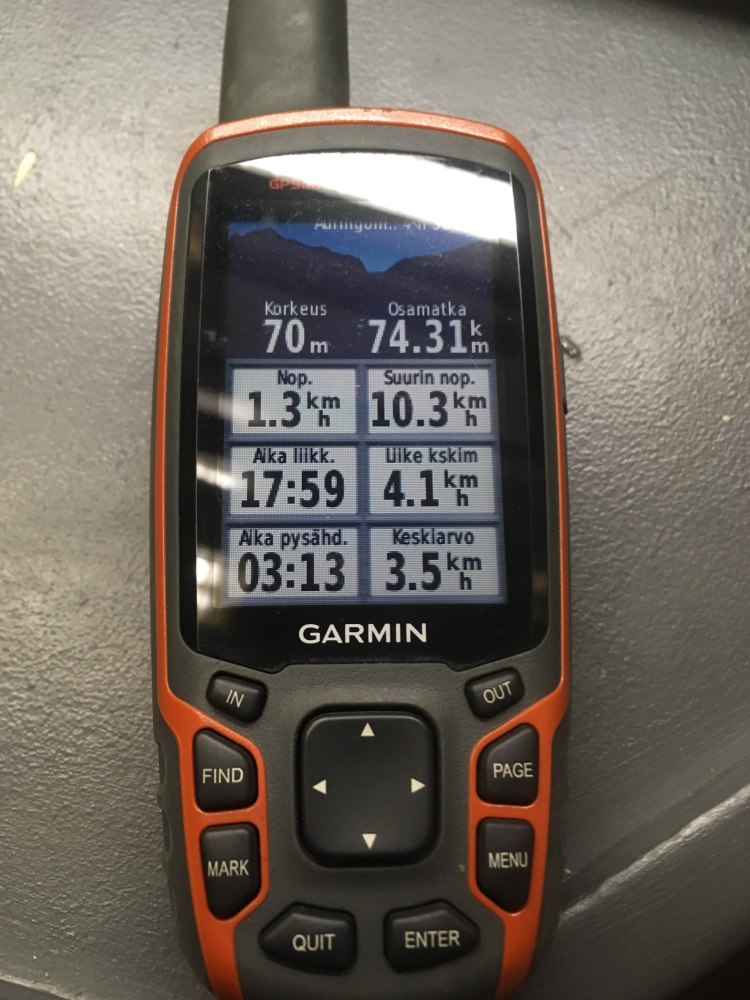
Real-life examples of the pace and balance between breaks:
| March 1 | March 2 | March 3 | March 4 | March 5 | March 6 | Total / avg. | ||
|---|---|---|---|---|---|---|---|---|
| Distance | 50 km | 50 km | 50 km | 100 km | 100 km | 50 km | 400 km | |
| Total time | 567 min | 531 min | 435 min | 1359 min | 1299 min | 551 min | 4742 min | |
| Time moving | 533 min | 476 min | 414 min | 1229 min | 1189 min | 513 min | 4354 min | |
| Breaks | 34 min | 55 min | 21 min | 130 | 110 min | 38 min | 388 min | |
| Breaks of total time | 6 % | 10 % | 5 % | 10 % | 8 % | 7 % | 8 % | |
| min/km moving | 10,66 min | 9,52 min | 8,28 min | 12,29 min | 11,89 min | 10,26 min | 10,89 | |
| min/km during total time | 11,34 min | 10,62 min | 8,70 min | 13,59 min | 12,99 min | 11,02 min | 11,86 min | |
| km/h moving | 5,63 km/h | 6,30 km/h | 7,25 km/h | 4,88 km/h | 5,05 km/h | 5,85 km/h | 5,51 km/h | |
| km/h during total time | 5,29 km/h | 5,65 km/h | 6,90 km/h | 4,42 km/h | 4,62 km/h | 5,44 km/h | 5,06 km/h |
Try to drink regularly and a little at a time during the march. A good amount is 2-3 dl (6.75-10 oz) every 10-15 minutes. Adjust as necessary depending on your pace, load and temperature. Avoid becoming very thirsty and maintain a normal need to take a piss. The color should be yellowish neutral, not deep yellow. Hydration is easy to forget in cold weather so keep it in mind.
Some athletes and daredevils have died from drinking too much, so don't take it to the other extreme, either. You don't lose 2 litres (half a gallon) of fluids in one hour so you should not drink that much, either. Overhydration can cause headaches and cramps, which could be mistaken for dehydration.
Water is what you need the most, but electrolytes are necessary to maintain a healthy sodium level. Sports drinks are effective alongside water to get sugars and salts. Find a concentration that your stomach can handle during the practice phase.
Don't forget to eat something with energy and salt. Nuts, pizza, whatever works for you. The key is to have tested your snacks in advance so you won't run into digestive problems during the march. The goal is to keep blood sugar and sodium levels balanced. See this product group for food and cooking gear.
Example One, 50 km (31 mi) march sustenance kit:
- 3 liters (101 oz) of water in a hydration reservoir
- 2 liters (68 oz) of water in canteens
- 1 litre (1 qt) of sports drink in a canteen
- 3 pcs of Clif Bars or other energy bars
- 2 bags of salted peanuts
- 2 pcs of triple-salami and cheese sandwiches
- 2 bags of sports drink powder
- Magnesium citrate granules
Example Two, 50 km (31 mi) march sustenance kit:
- 4 liters (1 gallon) of water in canteens (not inside the ruck)
- 1 liter (1 qt) of water in the ruck (emergency bottle)
- Sports drink concentrate (effervescent tablets are handy and neat to use)
- Nut selections (vary the tastes!)
- Sliced salami / jerky
- Chocolate (or liquorice in hot weather)
- Energy gels
- Coarse sea salt - wonderful to let these dissolve on the tongue
The idea is to pack several snack bags to be opened and chowed every x klicks. Each bag will have nuts, salami, chocolate and gel. This helps you maintain a fairly stable energy level all the time. You can burn 5000-6000 kCal during a 50 km march with a backpack (10-20 kCal / min) so eating is really a task. Eating on your feet allows you to avoid a separate break for eating.
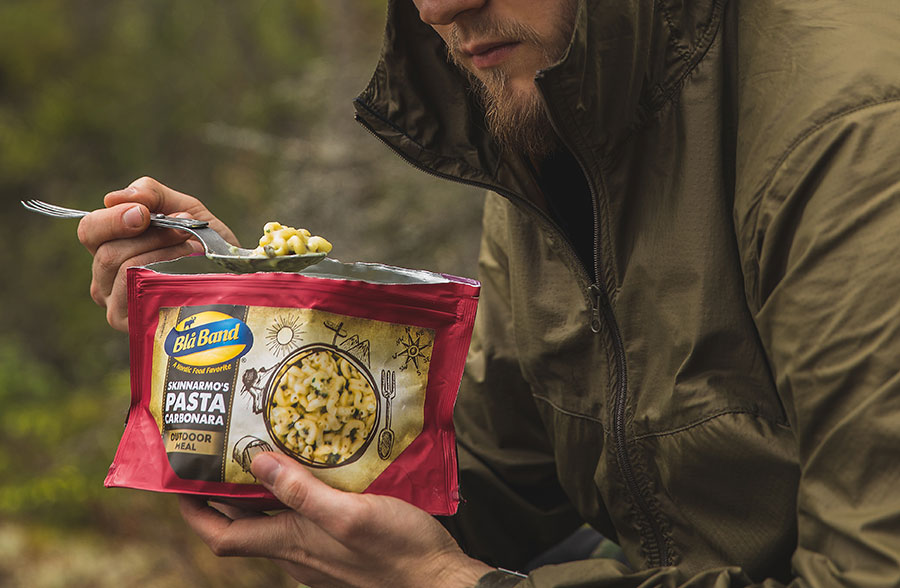
Eric's Pro-Drifter Sustenance Set for a 50 km (31 mi) march:
- 4 liters (1 gallon) of water
- 4-6 beers (cans weigh less than bottles)
- Tyrkisk Pebers or other means to say goodbye to the roof of your mouth
- Pizza - get this the day before and pack slices separately
- Plan your route so that there are food trucks, snack bars and such on the way to get some fritters and coffee
You will need one or several breaks on the way, depending on the distance. This is the time to clean and dry your feet and air them a little. Eat and drink if you have time. Change into dry and clean socks and fix your equipment if necessary. About halfway is a good time for this, or the 1/3 and 2/3 milestones of the total distance if it's a long march.
Frankly, it will be impossible to avoid some kind of hardship. You'll be sore or tired in various places, walking becomes boring or morale gets otherwise low. These are entirely normal reactions and you can push through them with confidence in yourself and the plan.
Discomfort and aches are part of marching, especially over long distances. Knowing your body and listening to it is important: if you have alarming pain in the knee, ankles, back or other part of you that can be injured, stop going. An injured soldier is no good, don't break yourself.
Monitor everything about your body to your best ability. If your sock isn't on right or there's something in your boot, fix it right away. Many large blisters have started from the idea that you don't want to stop for a minor issue. Given time, small problems become large and complex problems.
Final words
Marching is a delightful way to be outdoors, get fit and refresh your mind. You can do it individually or as part of a group. The threshold is low (it doesn't require much in terms of money or physique) and you can do it every day. Even if you have bad memories from past marches or haven't done any, give it a try. With the right preparation and mindset you can be positively surprised. Your performance is not what matters, it's what you do with pride.
In addition to local marching events, you can attend our annual Varusteleka's Remote Military March in case you like the mental support of doing things together.
